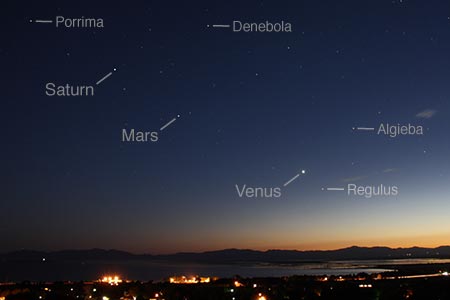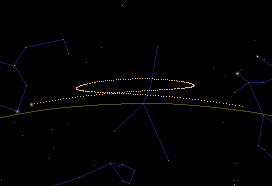The Planets
Besides the sun, moon, and stars, there are five other prominent objects
in the sky: the planets Mercury, Venus, Mars, Jupiter, and Saturn. Their complex motions mystified
ancient people, and eventually motivated the development of modern astronomy.
Appearance
To the naked eye, each of these five planets looks like a bright
star. Venus is the brightest, brighter than any star and sometimes visible in the
daytime (if you know where to look). Jupiter is also brighter than any star, while Mars
is quite variable, sometimes as bright as Jupiter and sometimes only a little brighter
than the North Star. Mercury and Saturn are never as bright as Jupiter, but
are still brighter than all but a few of the stars.
Exercise: Use the
Sky Motion Applet
to determine which planets are currently visible in the night sky, and at what times, and
in which directions.
Question: The photo above was taken on a July 2010 evening from northern
Utah. Use this information and the
Sky Motion Applet
to reproduce this configuration of
the planets with respect to the surrounding stars. On what date in July was the photo taken?
Motion
Although the planets look like stars, their motions through our sky
are much more complicated.
On any given day/night, they rise and set like a star would. But like
the sun and moon, they gradually wander among the twelve constellations of the zodiac,
always staying close to the ecliptic.
In fact, the word "planet" comes from the Greek word for "wanderer", and in this sense,
the sun and moon were also originally classified as planets. One vestige of this old
classification is our names for the days of the week, one for each of the seven
original "planets" (see table at right). Nevertheless, to avoid confusion, I'll use
the word planet (in this chapter) to refer only to the five star-like wanderers, not
including the sun and moon.
Besides their star-like appearance, the planets differ from the sun and moon in the
details of their motions. Recall that the sun and moon both move along (or near) the
ecliptic from west to east—that is, leftward if you're at a northern latitude,
looking up into the southern sky. The five planets also move from west to east most
of the time, but not always. Instead, they periodically slow down (with respect to the
stars), stop, and reverse direction, moving from east to west. Then, after a few weeks or
months,
they reverse direction again, resuming the usual eastward motion. The more common eastward
motion is traditionally called forward motion, while the less common westward
motion is called retrograde motion.
Retrograde motion is easy to observe, as long as you're somewhat familiar with the
constellations and have enough patience to make observations over several nights.
The retrograde motions of Mars, Jupiter, and Saturn conveniently occur when they are
opposite the sun in our sky, and hence visible all night long; we then say that they're
at opposition. These planets are also
at their brightest when at opposition, though the brightness differences aren't nearly
as great for Jupiter and Saturn as they are for Mars. The time interval between one
opposition and the next is about 780 days for Mars, 399 days for
Jupiter, and 378 days for Saturn.
Venus and Mercury, on the other hand, are never opposite the sun in our sky. Instead
they stay relatively close to the sun: Venus within about 47 degrees and Mercury within
about 28 degrees. This means that these planets can be visible either in the western sky after
sunset, or in the eastern sky before sunrise, but never near midnight.
Mercury, in particular, is hard to observe over long periods because it is always
so close to the sun.
Retrograde motion, for either Mercury or Venus, occurs when the planet has been visible in our
evening sky, then quickly approaches the sun (from our perspective) and later appears on its
other side, in our morning sky. The planet's forward motion then gradually carries it back
toward the sun from the other side, and eventually back into our evening sky.
This pattern repeats about every 584 days for Venus and every 116 days
for Mercury.
To help you visualize these motions, I've created a
Whole Sky Applet
that draws the planets on a map of the entire (360-degree) sky. Please spend some time
playing with this applet, watching the forward and retrograde motions of each of the
five planets. Then use this applet (or the
Sky Motion Applet) to answer
the following questions.
Question:
Observe the forward and retrograde motions of Jupiter. About how long does each period of retrograde
motion last?
Question:
As shown above, Mars was in the constellation Cancer during its retrograde motion in late 2009 and early 2010.
Which constellation will Mars be in during most of its next retrograde motion, in early 2012?
The intricate motions of the planets were a wonder and a mystery to ancient people who
took the time to observe and ponder them. It was natural that most ancient people considered
the erratically moving planets to be deities, with wills of their own.
It was also natural for people to conjecture
that, like the sun and the moon, the planets might have noticeable effects on our daily lives
here on earth. This idea was developed into astrology,
a subject that gets far more attention than astronomy even in today's newspapers and bookstores.
Meanwhile, the
ancient Greeks eventually attempted to devise mechanical models to explain (and predict)
the complex motions of the planets. These efforts are described in the following chapter.
Copyright ©2010-2011 Daniel V. Schroeder.
Some rights reserved.

